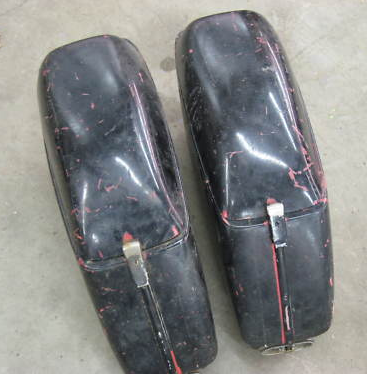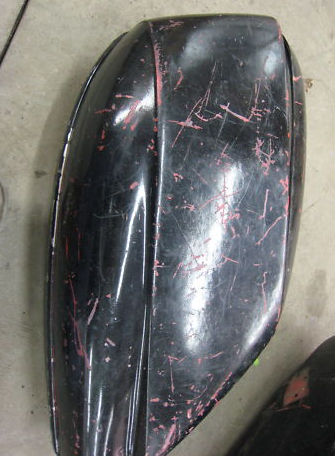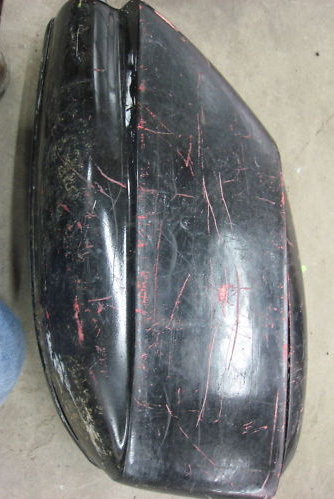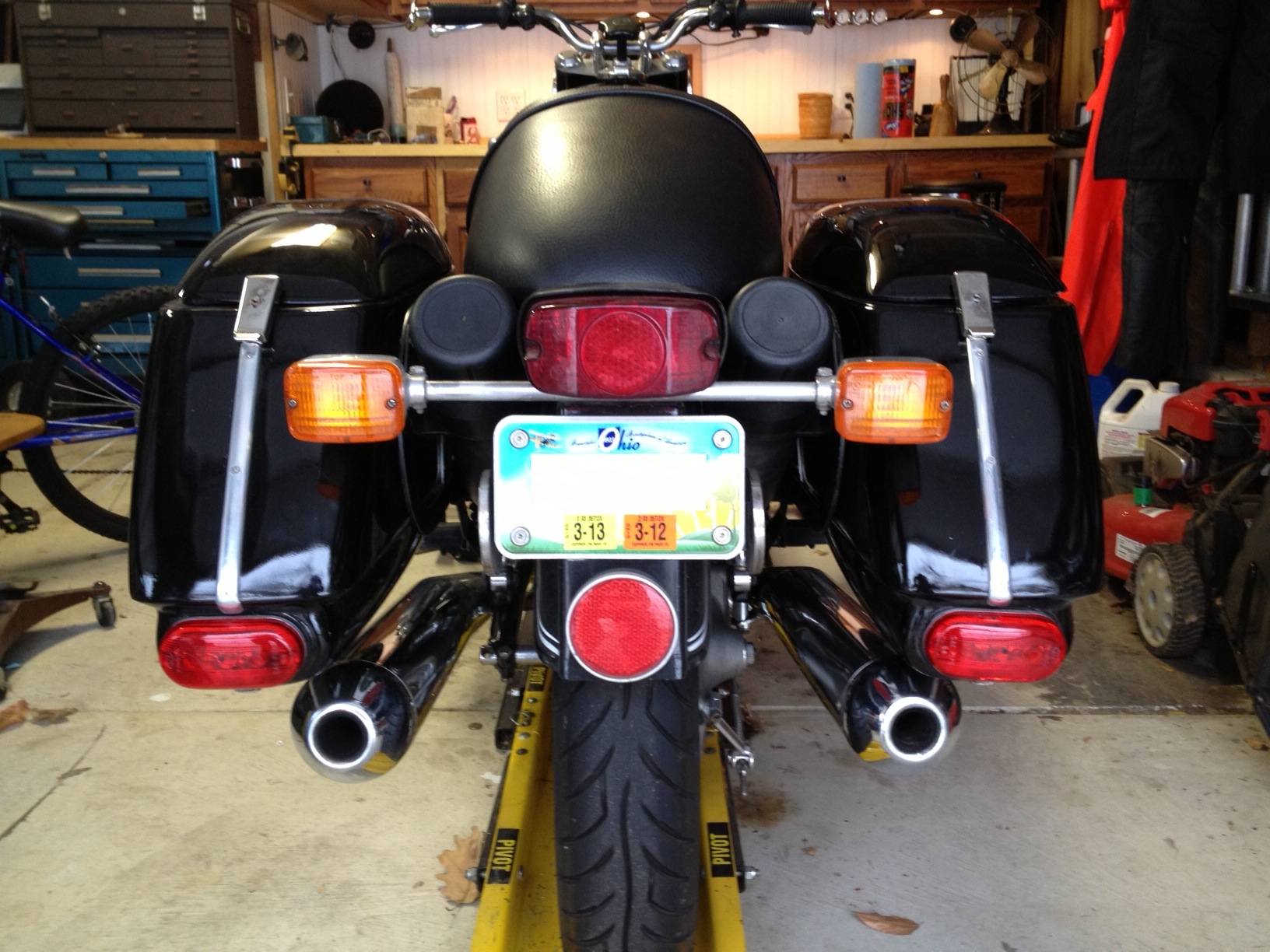Days before I picked up Die Hexe her Krauser bags (along with her side-covers) were stolen. While there is a special place in hell for folks who do such things to old bikes, in the end I think it turned out for the best. Looking around at the price of replacement Krauser bags was quite an eye-opening experience. The 300$ asking price for good-excellent condition bags for was more than I was willing to pay. In part becuase of the price, but in part because of the design. The flowing curves of the /5 bikes seemed at odds with the squared off, typewriter-esque carrier cases of the Krasuers. Looking around a bit more, however, I found a few examples of early 70's BMW sporting Wixom's and that was the end of that.
If anyone is interested in a fine set of Karuser brackets, just let me know. I have an extra set now simply collecting dust.
Wixom Bros Ranger Saddlebags - before restoration
As luck would have it, I found a prety beat up (but structurally in good condition) pair of Wixom Bros Ranger Saddlebags on Craigslist for $50. There were originally gel-coat? red and later painted black. The locks were in bad shape (but functional) and no lights or reflectors, but for the price I couldn't pass them up.



Mounting brackets
The mounting bracketes were a bit more difficult to find, but in the end I found a set that worked for SWB /5. Here they are sanded and repainted.


Restoration
@@ one of these days write this up @@
- Remove pop-riveted aluminum and re-polished to chrome like finish
- Remove locks and rebuild
- Sand (and sand, and sand, and sand), primer, paint (and sand some more)
Final product
Here are a few shots of the wixoms mounted after resotration.
And a couple more as things stand currently.
Additional modifications - Tool Tubes
I love these Wixom bags on my /5. One (small) gripe I have, however, is the extra gap that exists between the mounting bracket and the bike. I've always thought that gap was prime for additional storage compartments. After thinking about this a bit more, I came up with the idea of fitting a pair of (inexpensive) tool tubes on the inside of the mounting brackets. The spacing is (almost) too tight, but by positioning these tubes at the right angle, a fairly effective fit can be achieved.
And the fact they can hold a couple extra bottles of wine doesn't hurt either ;)
Special thanks
- To the guy who sold me these Wixoms for 50$.
- Scott A for his assistance in helping me fit these bags
Ready Reference
- Saddlebags - Wixom by Gregory Bender
- BMW Motorcycle saddlebags by Wixom by Duane Ausherman
Background on Wixom
NOTE: the following is snipped from http://capttop.blogspot.com/ as the site seems to be sketchy
The following is from Motorcycle Years from "Motorcycle Design" by Craig Vetter. This is from the manuscript of a new book on the History of Motorcycle Design after 1939 by Craig Vetter, motorcycle designer and now historian and writer.
Preface to Wixom, May 24 1967: The "Summer of Love". I rode my 350 Yamaha from Illinois to LA to interview people who had already done the kinds of things that I wanted to do. I scheduled visits with Floyd Clymer, Bruce Meyers, Bill Van Tech and Dean Wixom to ask them what advice they could give me so I would not make the same mistakes they made. Well, I wanted take a trip too. All right, I also wanted to check out Haight-Ashbury in San Francisco.. Floyd Clymer, founder and owner of Cycle Magazine, was ornery and uncooperative. He wouldn't even let me ride his Munch Mammoth. Bruce Meyers, inventor of the Meyers Manx dunebuggy, advised me to spend all my efforts on molds: "Get them as perfect as you can". ( Bruce was forever haunted by a crooked rear fender on his Manx ) Bill Van Tech must have made a some kind of mistake because by the time I got to LA, he was employed by Grant Industries and "unavailable". Dean Wixom, fairing designer, was a real gentleman, taking me under his wing, even inviting me to stay at his home. We had taken two very different approaches to fairing design. The Wixom fairing mounted to the handlebars while the Vetter fairing mounted to the frame. Dean could see that I too had designed for the American riding style. "Really", he said, "the only advice I can give you is that very few people are going to pay $100 for a fairing". I couldn't do that. It cost me too much to make! I was counting on the fact that there would be a place for my design too. We became friends and competitors in the fairing business. But, it wasn't until researching for this book that I learned just how far his influence extended through motorcycling. I am honored to tell of his contributions to motorcycle design. America's first fairing designer, Dean Wixom May 24, 2005 Dean Wixom was an industrial arts student in Long Beach in 1960. He rode a BMW with an English Peel fairing, which he recognized as not being right for the American riding style. Dean had learned fiberglass at a summer job in high school. You know what came next. . By 1964, Dean Wixom was getting America warmed up to fairings. Dean Wixom was a motorcyclist. He understood materials and he had a good sense of design. And he was industrious. He had all the ingredients for success. Dean designed and made what he wanted on his motorcycle. In so doing, he made what many American riders wanted too. Brother, Stan left his job at IBM to invest in the venture. Wixom Brothers became the biggest fairing manufacturer in America. There were challengers Avon and Butler, the major fairing companies in England, now set up distributors in the US to sell Café Fairings - which were street versions of streamlining they saw on the tracks. They were called cafe fairings because the English Rockers of the era used them as they raced from café to café. Americans thought they looked cool, but we did not ride from café to café. We rode from coast to coast. The Wixom Brothers understood that. They made real touring fairings for the way Americans rode: The Wixom Brothers struck gold in 1966. When the Wixoms put their fairing on the Harley Big Twin, they hit the mother lode of the fairing business. The Wixom /Harley combination became one of the All time Classic Designs of motorcycling. Forty years later, Dean's design lives on in the Harley Davidson "Batwing": 1967: The Summer of Love and Airflow Dean Wixom's motorcycle career is entwined with that of famous engine designer, Jerry Branch. When Dean was beginning, Jerry was working as a mechanic at a local Harley shop, learning how engines breathed – or "flowed". Legendary Harley Racing Manager, Dick O'Brien had come to rely upon Jerry Branch. In 1967 Jerry Branch set up shop flowing engines above the Wixom Brothers' fairing factory on Signal Hill in Long Beach, CA. In 1967, Dick O'Brien told Jerry that Harley wanted to win Daytona in 1968. Think about it: The OHV Triumph had won in 1967. In 1968 the Yamaha 350 would be here, ridden by the best Americans and international riders from Europe. How could they possibly make their old, 1953 flat-head design competitive? Jerry Branch knew what to do with the engine and he knew just where go for the right fairing design. It was that summer that I met Dean and Jerry on Signal Hill. Dean hinted about something exciting they were working on but could not talk about. Thirty eight years later they talked. Dick O'Brien had told them he was prepared to do whatever it took to win Daytona. He began by buying a block of time at the Cal Tech wind tunnel. The AMA had not allowed streamlining on Class C road racing machines until a few years earlier in1962, so nobody in the US really knew how to tell a good race fairing from a bad one. Dean and Jerry were about to find out. The cuurent H-D racer had xxx hp would go 135, not enough to win Daytona any more. Dean tells of the hours they spent, adding clay here and there - finally giving up and building a new fairing from scratch. Until they spent their time in the wind tunnel, everyone had assumed that a skinny fairing was better. Everyone was wrong. The fairing and seat, they discovered, needed to be as wide as the man on the bike to help the air flow by easily. One of the surprise sources of air drag, incidentally, turned out to be the "whetted area" of the air entering the engine opening. When they taped over the opening, the drag went down measurably. Each time the air slams into something – the forks, the frame tubes, the engine cases, the fins - it causes drag. Besides shaping the fairing and seat, Dean sculpted the beautiful new 6 gallon fuel tank while Jerry focused on getting the fuel/ air mixture into the engine and getting it burned. Jerry upped horsepower to xxx. Dean did the "big air" while Jerry did the "little air". The top speed rose to over 150 mph. As Don Emde, fellow road racer, says in his book: The Daytona 200, "When they arrived in Daytona for the 1968 races, the team bikes did not even remotely resemble the machines of the year before. They were all painted in identical Harley orange, black and white colors" Harley did indeed win Daytona in 1968, and again 1969. Cal Rayborn shocked the world winning the 1968 Daytona on that old Flathead KR TT. Vetter Design Truth #10: "There is no more new frontier… We will have to make it here" … is bunk. (Eagles, Last Resort") Designers get to work in new frontiers. Dean and Jerry agree that he FIM streamlining rules of 1957 which require the rider and wheels to be exposed, make it virtually impossible to really streamline a racing motorcycle today. The biggest area of improvement, they found, was to help the air flow smoothly over the rider's back. This was so important, Dean says, that he flew to Daytona a few days early to personally hand-cut each windshield to fit each individual rider in the Harley team! Wixom had designed the best road race stream;ining possible. Period. Any deviation from this design would be contrived just to be different. It seems unlikely that it could be more efficient. The story is not over Harley had found One-Stop Shopping on Signal Hill. After their 1968 success, Dick O'Brien brought over the first XR 750 chassis for the Jerry and Dean to finish up. Again, Dean designed and built the tank and seat while Branch made the heads flow. 1970 Harley XR 750 (picture) Wixom and Branch had produced another classic, being produced until xxx. Maybe the most rewarding part of this venture is, according to Dean, that Willie G. Davidson, in charge of Harley's design, simply rubber-stamped it. The last fairing that Dean designed before selling Wixom Brothers ended up as the ubiquitous CHP fairing made famous on the TV show, Chips. The brothers sold their fairing company in 1977 and went on to design another classic, the Nor'sea 27 sailboat. This fibreglass sailboat has been in production longer than any boat in history. Dean now enjoys a third career inlaying gemstones, in a process called "Intarsia". Only a handful of artists produce intarsia in the US. In 2007 Dean won the coveted "Gemmy Award" this country's highest award for the Gemcutting Arts. . You may E-mail encouragement to him at: ndw1928@yahoo.com Stan Wixom died in 2004. Jerry Branch is the world's youngest 80 year old. (See Jerry Branch ) Dean Wixom was nominated to the Motorcycle Hall of Fame in 2007










